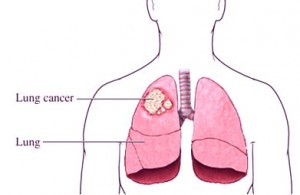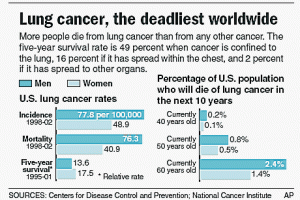Symptoms of lung cancer in men are different from the symptoms of the disease in women. There are different types of lung cancer, and the symptoms often vary with the type of lung cancer the individual is suffering from. Usually, men with lung cancer are often associated with heavy smoking.
Cancer is a disease caused by the growth and the spread of abnormal cells in the body. Lung cancer happens when the growth of these cells originates in the lungs. These abnormal cells continue to grow and develop into a tumor. The tumor inside the lungs would hinder the lung’s function to provide oxygen to the bloodstream to be circulated throughout the entire body.
Types of Lung Cancer and their Symptoms
There are two main types of lung cancer classified according to their microscopic appearance:
Non-small cell lung cancers (NSCLC)
Under the microscope, the cells for this type of cancer are bigger compared to the small cell lung cancer. It has three subtypes that are classified according to where the tumor originated:
o Squamous cell carcinoma – This is the most common type of non-small cell lung cancer. The tumor is located on the lining of the bronchial tubes or the tissues that line the passageway to the lungs. This type of lung cancer is generally strongly linked to smoking.
o Lung Adenocarcinoma – This is the common type of NSCLC developed by women and nonsmokers. The abnormal cells are usually found on the mucus producing glands of the lungs. This subtype is not detected right away because the symptoms would take a long time before they become evident.
o Large cell cancer – This subtype of NSCLC grows rapidly on the outer regions of the lungs and appears large and round under the microscope.
Small cell lung cancer
The cancer cells appear small and scattered, and look like oatmeal. These would grow into big tumors that could spread throughout the body. This type usually originates on the bronchi.
Signs and Symptoms of Lung Cancer in Men
Since the tumor is in the lungs, the symptoms of lung cancer in men are usually associated with the alteration of the normal breathing because of the impairment of the respiratory system. Here are the common signs and symptoms of lung cancer in men:
o Constant coughing – When there is lung cancer, the bronchi is congested with abnormal cells that are now growing to form a tumor. The person will try to breathe normally, but due to this blockage, the breathing would be disrupted and a persistent cough would develop instead.
o Hemoptysis – This is when an individual starts to cough out blood due to the irritation of the air passageway from constant coughing.
o Swelling – Some areas of the neck and face would be inflamed causing evident swelling on the said regions.
o Shortness of breath – This is also one of the common symptoms of lung cancer in men because of the blockage of the tumor inside some parts of the lungs. The affected individual often suffers difficulty in breathing.
o Wheezing – When the individual with small cell lung cancer exhales, a whistling sound can be heard. The air will have difficulty in going out due to the narrowed airways.
o Infection of lungs – Infections like recurrent bronchitis and pneumonia can occur due to the bacteria that may be trapped in the tumors in the lungs.
o Fatigue and weight loss- There is considerable loss of weight and a person begins to feel weak on a continual basis.
o Gynecomastia – This is the medical term for the development of male breast. Some men with lung cancer may develop male breasts as the cancer is known to produce more estrogen in the body, thus resulting to larger breasts in men.
Treatment for Lung Cancer
The treatment for lung cancer depends on the type of lung cancer the individual is suffering from. However, there are three common ways in which the illness and its symptoms can be treated, namely, surgery, chemotherapy and radiation.
• Surgery – Surgery can be done if the lung cancer is still in its early stages and if the cancer cells have not yet metastasized or spread to other parts of the body. The surgery should be performed by a professional thoracic surgeon. The objective of the surgery is to remove the tumor and the surrounding lymph nodes and tissues. After the procedure is done, a series of tests will be conducted on the tissues in the lungs to check if there is more cancer cells found. This type of surgery could cause great harm to other organs near the lungs and so after the surgery, the doctor would prescribe antibiotics to help your body fight off possible infections.
• Radiation – Radiotherapy is also widely used for lung cancer patients. As the name connotes, radiotherapy makes use of high energy gamma rays given off by metals like radium. These gamma rays destroy the cancer tumors and the cells that have metastasizes in other parts of the body. The patient should be aware though that radiotherapy could make the symptoms of lung cancer in men manageable, but could also result to side effects such as loss of appetite, hair loss, and dry, sensitive skin.
• Chemotherapy – Chemotherapy is a form of cancer treatment wherein strong antineoplastics or anti cancer drugs are administered to thwart the cell division of the abnormal cells, making it impossible for them to multiply and destroying them in the process. There are anti cancer medicines specifically used to target the type of cell that causes the cancer of the lungs. Most chemotherapy cycles are given intravenously every week, or every month, depending on the severity of the disease. Chemotherapy also helps remedy or ease the symptoms of lung cancer in men. Helpful as this may be, chemotherapy could cause undesirable side effects like irritability, nausea, vomiting, hair loss, bleeding, extravasations and mouth sores.
The symptoms of lung cancer in men are rather painful and would often cause discomfort and irritability to the patient. When you or someone you know has the disease, it would be helpful to get to know the disease, to discuss any worries with the doctor, and seek support from your loved ones. The best thing a lung cancer patient can do is stick to the treatment regime, think positive and hope for the best.

